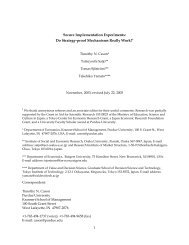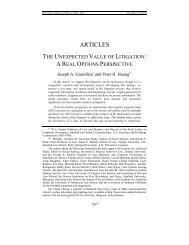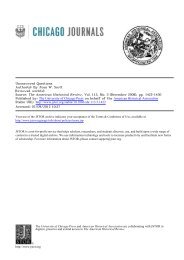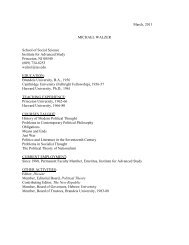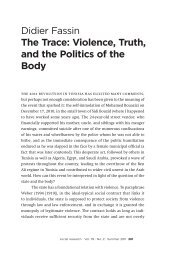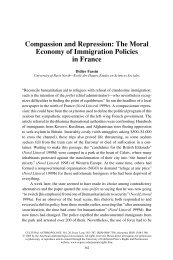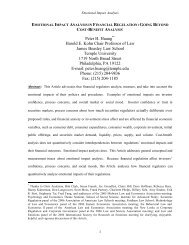The Tools of the Master Slavery and Empire in Nineteenth Century ...
The Tools of the Master Slavery and Empire in Nineteenth Century ...
The Tools of the Master Slavery and Empire in Nineteenth Century ...
Create successful ePaper yourself
Turn your PDF publications into a flip-book with our unique Google optimized e-Paper software.
10 THE TOOLS OF THE MASTER<br />
harsh <strong>and</strong> violent experience as well, result<strong>in</strong>g <strong>in</strong> many slaves’ deaths. But once safely<br />
ensconced <strong>in</strong> Egypt, almost all sources agree that <strong>the</strong> experience <strong>of</strong> Sudanese slaves was considerably<br />
milder than that suffered by African slaves <strong>in</strong> <strong>the</strong> Americas.<br />
<strong>The</strong>re is no agreement on <strong>the</strong> exact number <strong>of</strong> black slaves <strong>in</strong> Egypt dur<strong>in</strong>g <strong>the</strong> latter<br />
half <strong>of</strong> <strong>the</strong> n<strong>in</strong>eteenth century, when <strong>the</strong> trade <strong>in</strong> slaves from <strong>the</strong> Sudan reached its peak.<br />
Gabriel Baer wrote that while it was impossible to establish <strong>the</strong> exact number <strong>of</strong> slaves <strong>in</strong><br />
Egypt at any time <strong>in</strong> that century, he could estimate—on <strong>the</strong> basis <strong>of</strong> contemporary British<br />
accounts, <strong>the</strong> census <strong>of</strong> 1850 <strong>and</strong> from <strong>the</strong> records <strong>of</strong> <strong>the</strong> Slave Trade Bureaux established<br />
after <strong>the</strong> Anglo-Egyptian Convention <strong>in</strong> 1877—that throughout <strong>the</strong> century <strong>the</strong> number <strong>of</strong><br />
slaves rema<strong>in</strong>ed between 20,000 <strong>and</strong> 30,000. 27<br />
Judith Tucker never arrived at a total figure<br />
<strong>of</strong> slaves, although she posited that between 1877 <strong>and</strong> 1905, 25,000 slaves were manu<br />
mitted <strong>in</strong> Egypt. 28 <strong>The</strong> majority <strong>of</strong> African slaves <strong>in</strong> Egypt were women who served as domestic<br />
workers <strong>in</strong> private homes, although <strong>in</strong> upper Egypt <strong>the</strong>re were documented examples <strong>of</strong><br />
agricultural slavery, <strong>and</strong> many slaves were recruited for military service early <strong>in</strong> <strong>the</strong> century<br />
as well. 29<br />
<strong>The</strong>re was a well-established hierarchy <strong>of</strong> labor which constructed <strong>the</strong> work <strong>and</strong> world<br />
<strong>of</strong> <strong>the</strong> slave <strong>in</strong> Egypt <strong>in</strong> <strong>the</strong> n<strong>in</strong>eteenth century, itself a construction <strong>of</strong> stereo<br />
typ<strong>in</strong>g about <strong>the</strong> qualities <strong>of</strong> different races <strong>and</strong> ethnicities. White Circassian women were<br />
at <strong>the</strong> top <strong>of</strong> this ladder <strong>and</strong> were welcomed <strong>in</strong>to <strong>the</strong> harems <strong>of</strong> <strong>the</strong> wealthiest <strong>and</strong> most<br />
prestigious households. Ethiopian women came next, bought <strong>of</strong>ten as concub<strong>in</strong>es for <strong>the</strong><br />
middle class. <strong>The</strong>y were not prized for <strong>the</strong>ir household work as were o<strong>the</strong>r African women,<br />
who came lower on <strong>the</strong> scale. 30<br />
<strong>The</strong>re is, surpris<strong>in</strong>gly, much less <strong>in</strong>formation about <strong>the</strong><br />
nature <strong>of</strong> black males slaves’ work <strong>in</strong> Egypt <strong>in</strong> <strong>the</strong> late n<strong>in</strong>eteenth century. After <strong>the</strong><br />
resolution <strong>of</strong> <strong>the</strong> American Civil War, when Egypt’s cotton <strong>in</strong>dustry faced <strong>in</strong>tense competition,<br />
<strong>the</strong> large-scale plantation projects that <strong>the</strong> Khedive Isma’il had encouraged, <strong>and</strong> on<br />
which black slaves were employed, shrank. Little record is left about <strong>the</strong> future <strong>of</strong> work for<br />
those slaves.<br />
What <strong>the</strong> historical record makes clear, however, is that once purchased, most African<br />
slaves <strong>in</strong> Egypt worked <strong>in</strong> <strong>the</strong> homes <strong>of</strong> <strong>the</strong> middle <strong>and</strong> <strong>the</strong> upper classes. Baer cites examples<br />
<strong>of</strong> slaves dur<strong>in</strong>g <strong>the</strong> 1860’s <strong>and</strong> 70’s work<strong>in</strong>g for “bedu<strong>in</strong>s, village notables, fellahs,<br />
millers, butchers, shopkeepers, a bookseller, all k<strong>in</strong>ds <strong>of</strong> merchants, a banker, clerks, all<br />
grades <strong>of</strong> <strong>of</strong>ficials <strong>and</strong> government employees, all ranks <strong>of</strong> army <strong>of</strong>ficers, religious functionaries,<br />
some muftis, a judge, a physician <strong>and</strong> o<strong>the</strong>rs.” Some would have been a part <strong>of</strong><br />
large households with many slaves <strong>and</strong> servants, but <strong>the</strong> majority would have been part <strong>of</strong> a<br />
liv<strong>in</strong>g situation where <strong>the</strong>y were <strong>the</strong> only slave. <strong>The</strong>se might become a member <strong>of</strong> an <strong>in</strong>timate<br />
group, privy to all <strong>of</strong> <strong>the</strong> family life <strong>and</strong> dependent on its o<strong>the</strong>r members for <strong>the</strong>ir<br />
health, well-be<strong>in</strong>g, food <strong>and</strong> cloth<strong>in</strong>g. She or he would perhaps help raise <strong>the</strong> children <strong>and</strong>,<br />
<strong>in</strong> some cases, have children with <strong>the</strong> head <strong>of</strong> <strong>the</strong> household. Both Egyptian <strong>and</strong> British<br />
accounts testify to <strong>the</strong> fact that black slaves def<strong>in</strong>itely formed part <strong>of</strong> <strong>the</strong> family. 31<br />
What did <strong>the</strong> enforced domesticity <strong>of</strong> slavery mean? For many European observers, <strong>the</strong><br />
<strong>in</strong>timacy <strong>of</strong> this relationship <strong>and</strong> extension <strong>of</strong> family ties to slaves provoked a mixture <strong>of</strong> titillation<br />
<strong>and</strong> disgust, reactions similar to those elicited by <strong>the</strong> idea <strong>of</strong> <strong>the</strong> harem <strong>in</strong> Muslim<br />
societies. And slavery was very closely connected to <strong>the</strong> exoticism <strong>of</strong> <strong>the</strong> harem for<br />
European observers <strong>of</strong> <strong>the</strong> Middle East. By <strong>the</strong> last decade <strong>of</strong> <strong>the</strong> n<strong>in</strong>eteenth century, <strong>the</strong><br />
idea <strong>of</strong> <strong>the</strong> Egyptian family’s structure had become politicized with<strong>in</strong> Egypt <strong>and</strong> sharply<br />
scrut<strong>in</strong>ized from without, particularly <strong>in</strong> Great Brita<strong>in</strong> <strong>and</strong> France. European scholars like<br />
Ernest Renan debated <strong>the</strong> concept <strong>of</strong> marriage with<strong>in</strong> Islam, with <strong>the</strong> legality <strong>of</strong> polygamy,<br />
<strong>of</strong>ten draw<strong>in</strong>g conclusions that <strong>the</strong>se marriages were examples <strong>of</strong> a reflexive tendency



